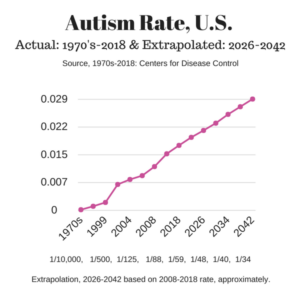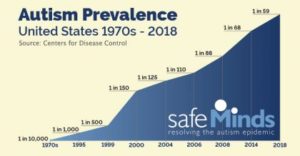The rate of autism in the 1970s was around 1 child in 10000. Prior to the 1930s the disease was barely heard of and only a few children, fewer than ten, had even been documented in psychiatric medical records as having any symptoms similar to the autism spectrum symptoms. (Denial/Blaxill, Olmsted)
Around 1999 to 2000 there was a sharp increase in the rate of autism diagnosed. Changes in awareness and/or diagnosis criteria may have some impact on short term changes but the increase in rate from the 1970s is significant. Extrapolating into the future following the recent rate of change in the rate of children diagnosed with autism takes us to an estimated rate of 1 in 34 children in the year 2042. We all need to ask ourselves if now is a better time to try to prevent autism from occurring in our nation’s children or if we should wait until 2042. There are multiple risk factors including specific timing during the infant’s prenatal development, exposure to certain toxins, and nutrient deficiency and/or genetic susceptibility – complex, yes, but complex just takes a little more work to handle.


Improved screening for risk factors of mothers during perinatal and prenatal care and screening of infants and toddlers before symptoms occur could help provide individualized guidance to help reduce known risk factors associated with increased risk of developing autism.
On another website I have a start on self care steps for preventing autism and other chronic illnesses for different stages of life:
This series of pages titled as Step 1, Step 2, etc. is a draft of steps for how to prevent autism or other chronic illnesses:
- Step 1: Believing is the First Step Towards Change.
- Step 2: Self Care for Prenatal Health, Part One.
- Step 2: Part Two, Self Care for Prenatal Health.
- Step 2: Self care prenatally: Why? What about everybody else?
- Step 3: Let’s Protect Against All Disease During Infancy.
- Needs to go in Step 3, which is in early stages of draft: Newborn screening for autism – 3 sets of 5 potential biomarkers
- (Biomarkers are ways to tell that the baby’s body chemistry, lab tests, are different than typical using the umbilical cord blood sample that is already being collected and used for other screening purposes – it would just add expense, so first set of five simplest tests would be done on all infant’s samples and those who had the differences noted in children who later in life developed autism, would be screened for the second set of five and those who continued to have the noted differences in lab values would have the third set of five lab tests performed on the cord blood sample; the series of testing provides increased accuracy of results while saving some time and money on the number of biomarkers involved. It is a complex problem, requiring complex strategies. The infants who tested with the differences could then have nutrient deficiency and genetic screening tests done for the known risk factors and social and lifestyle factors could be evaluated in the home (things like vinyl flooring and poor air circulation, especially if there is a smoker in the house or large numbers of decorative candles).
- More about formaldehyde, it may be a risk factor for many types of chronic illness across the lifespan. It is a toxin found in vinyl flooring and second hand smoke: Formaldehyde: Health Risk and Environmental and Dietary Sources.
Disclaimer: Opinions are my own and the information is provided for educational purposes within the guidelines of fair use. While I am a Registered Dietitian this information is not intended to provide individual health guidance. Please see a health professional for individual health care purposes.
